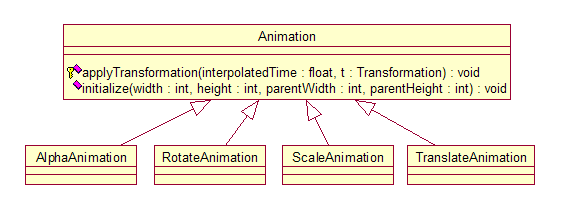framework 之 Animation
一、前言:
Animation是OS 4.0以前就有的一个动画框架,源代码位于SDK / android / view / animation下,此目录下还有自带实现的几种动画类,和一些Interpolater(插补器),不过,它只实现了基础的动画效果,见UML图。此类是对整个View做了动画效果,但是效率较低,因此在OS4.0 之后,又添加了新的动画框架:Animator。本篇文章只讲Animation,以后会写篇关于Animator的文章。
二、UML图:
图中,显示系统提供了四种动画:透明、旋转、缩放和位移。
三、详细讲解抽象类Animation:
3.1 如何使用Animation
使用它有两种方法:
1. 写一个xml文件,里面定义了一些animation效果,可以是一个效果,也可以是一组(AnimationSet);
2. 继承Animation,自己写个,或者使用系统提供的那四种;
因此,Animation初始化也对应两种方法:
/**
* Creates a new animation with a duration of 0ms, the default interpolator, with
* fillBefore set to true and fillAfter set to false
*/
public Animation() {
ensureInterpolator();
}
/**
* Creates a new animation whose parameters come from the specified context and
* attributes set.
*
* @param context the application environment
* @param attrs the set of attributes holding the animation parameters
*/
public Animation(Context context, AttributeSet attrs) {
TypedArray a = context.obtainStyledAttributes(attrs, com.android.internal.R.styleable.Animation);
setDuration((long) a.getInt(com.android.internal.R.styleable.Animation_duration, 0));
setStartOffset((long) a.getInt(com.android.internal.R.styleable.Animation_startOffset, 0));
setFillEnabled(a.getBoolean(com.android.internal.R.styleable.Animation_fillEnabled, mFillEnabled));
setFillBefore(a.getBoolean(com.android.internal.R.styleable.Animation_fillBefore, mFillBefore));
setFillAfter(a.getBoolean(com.android.internal.R.styleable.Animation_fillAfter, mFillAfter));
setRepeatCount(a.getInt(com.android.internal.R.styleable.Animation_repeatCount, mRepeatCount));
setRepeatMode(a.getInt(com.android.internal.R.styleable.Animation_repeatMode, RESTART));
setZAdjustment(a.getInt(com.android.internal.R.styleable.Animation_zAdjustment, ZORDER_NORMAL));
setBackgroundColor(a.getInt(com.android.internal.R.styleable.Animation_background, 0));
setDetachWallpaper(a.getBoolean(com.android.internal.R.styleable.Animation_detachWallpaper, false));
final int resID = a.getResourceId(com.android.internal.R.styleable.Animation_interpolator, 0);
a.recycle();
if (resID > 0) {
setInterpolator(context, resID);
}
ensureInterpolator();
}
一个是直接调用一个叫ensureInterpolator的方法,另一个是先使用系统默认的一些style,然后,再调用ensureInterpolator,那这个方法到底做了啥呢?我们来看看:
/**
* Gurantees that this animation has an interpolator. Will use
* a AccelerateDecelerateInterpolator is nothing else was specified.
*/
protected void ensureInterpolator() {
if (mInterpolator == null) {
mInterpolator = new AccelerateDecelerateInterpolator();
}
}
如果没有设置interpolater,那么,我们就使用一个先加速后减速的插补器,关于插补器,看我另一篇博文:
http://blog.csdn.net/qingye_love/article/details/8859347
3.2 成员属性
主要成员有:
1. mDuration:动画持续时间;
2. mStartOffset:某个动画的开始时间;(一组动画中,可以设置并发,或串行)
3. mFillEnabled,mFillBefore,mFillAfter:动画结束后是否回到初始状态,或者保持结束状态,默认是回到初始状态;
4. mRepeatCount,mRepeatMode:动画是否重复,重复次数,重复模式(从头开始,从头到尾再到头等);
5. mInterpolator:插补器,控制动画的快慢;
3.3 成员方法
动画开始方法:
public void setStartTime(long startTimeMillis) {
mStartTime = startTimeMillis;
mStarted = mEnded = false;
mCycleFlip = false;
mRepeated = 0;
mMore = true;
}
/**
* Convenience method to start the animation the first time
* {@link #getTransformation(long, Transformation)} is invoked.
*/
public void start() {
setStartTime(-1);
}
/**
* Convenience method to start the animation at the current time in
* milliseconds.
*/
public void startNow() {
setStartTime(AnimationUtils.currentAnimationTimeMillis());
}
start与startNow的区别可能在于,一个有点延迟,一个立马开始。
Animation类中最主要的方法: getTransformation,这个方法只计算已经过了多久,然后调用之前创建的Interpolater来计算速率,并最终调用重载Animation类的applyTransformation方法来完成你想要展现的动画效果,那么我们来看看方法的实现吧:
/**
* Gets the transformation to apply at a specified point in time. Implementations of this
* method should always replace the specified Transformation or document they are doing
* otherwise.
*
* @param currentTime Where we are in the animation. This is wall clock time.
* @param outTransformation A transformation object that is provided by the
* caller and will be filled in by the animation.
* @return True if the animation is still running
*/
public boolean getTransformation(long currentTime, Transformation outTransformation) {
if (mStartTime == -1) {
mStartTime = currentTime;
}
final long startOffset = getStartOffset();
final long duration = mDuration;
float normalizedTime;
if (duration != 0) {
normalizedTime = ((float) (currentTime - (mStartTime + startOffset))) /
(float) duration;
} else {
// time is a step-change with a zero duration
normalizedTime = currentTime < mStartTime ? 0.0f : 1.0f;
}
final boolean expired = normalizedTime >= 1.0f;
mMore = !expired;
if (!mFillEnabled) normalizedTime = Math.max(Math.min(normalizedTime, 1.0f), 0.0f);
// 前面的部分是计算normalizedTime,这里开始才是调用执行
if ((normalizedTime >= 0.0f || mFillBefore) && (normalizedTime <= 1.0f || mFillAfter)) {
if (!mStarted) {
if (mListener != null) {
mListener.onAnimationStart(this);
}
mStarted = true;
if (USE_CLOSEGUARD) {
guard.open("cancel or detach or getTransformation");
}
}
if (mFillEnabled) normalizedTime = Math.max(Math.min(normalizedTime, 1.0f), 0.0f);
if (mCycleFlip) {
normalizedTime = 1.0f - normalizedTime;
}
final float interpolatedTime = mInterpolator.getInterpolation(normalizedTime);
applyTransformation(interpolatedTime, outTransformation);
}
// 完成了applyTransformation的调用,后面计算动画是否循环
if (expired) {
if (mRepeatCount == mRepeated) {
if (!mEnded) {
mEnded = true;
guard.close();
if (mListener != null) {
mListener.onAnimationEnd(this);
}
}
} else {
if (mRepeatCount > 0) {
mRepeated++;
}
if (mRepeatMode == REVERSE) {
mCycleFlip = !mCycleFlip;
}
mStartTime = -1;
mMore = true;
if (mListener != null) {
mListener.onAnimationRepeat(this);
}
}
}
if (!mMore && mOneMoreTime) {
mOneMoreTime = false;
return true;
}
return mMore;
}
这个方法中,还有一个成员是mListener,它的类型是AnimationListener,在这个Animation类的末尾,定义了AnimationListener接口,继承Animation类的子类可以使用此接口,来监听比如动画开始时要做保存工作,动画结束时要做清除及恢复工作等。
/**
* <p>An animation listener receives notifications from an animation.
* Notifications indicate animation related events, such as the end or the
* repetition of the animation.</p>
*/
public static interface AnimationListener {
/**
* <p>Notifies the start of the animation.</p>
*
* @param animation The started animation.
*/
void onAnimationStart(Animation animation);
/**
* <p>Notifies the end of the animation. This callback is not invoked
* for animations with repeat count set to INFINITE.</p>
*
* @param animation The animation which reached its end.
*/
void onAnimationEnd(Animation animation);
/**
* <p>Notifies the repetition of the animation.</p>
*
* @param animation The animation which was repeated.
*/
void onAnimationRepeat(Animation animation);
}
四、总结:
Animation类的讲解,只是一个抛砖引玉,让大家在继承或使用其子类时,能够更好的去理解其原理,正如本文开头所说,在Android OS4.0之后,又出现了一个新的叫Animator类,之所以新添加了一个动画框架,其原因:
1. Animation能力有限,即便是将4种效果组合来用,也无法达到某些高级特效的效果;
2. Animation需要对整个view进行动画,这也导致其性能较低;
而Animator弥补了这些,因此争取有空时,将Animator也讲解一下。
写的不好的地方,也请大家指出来,谢谢!
